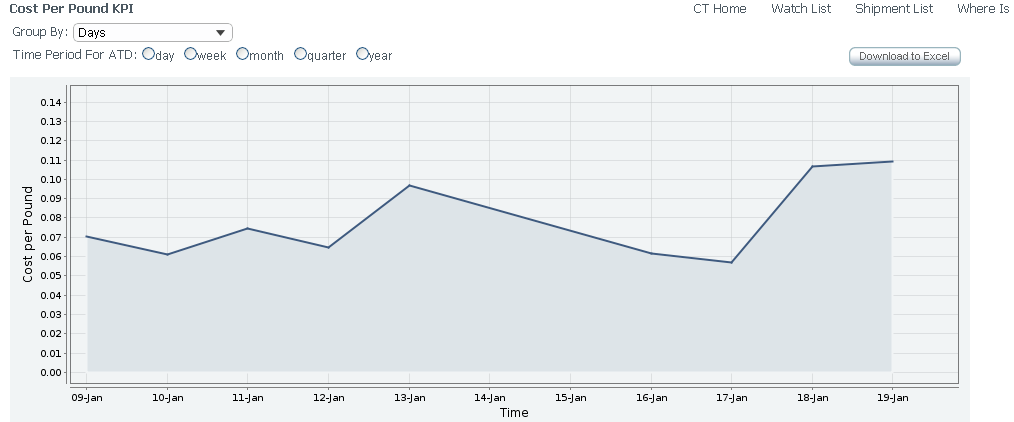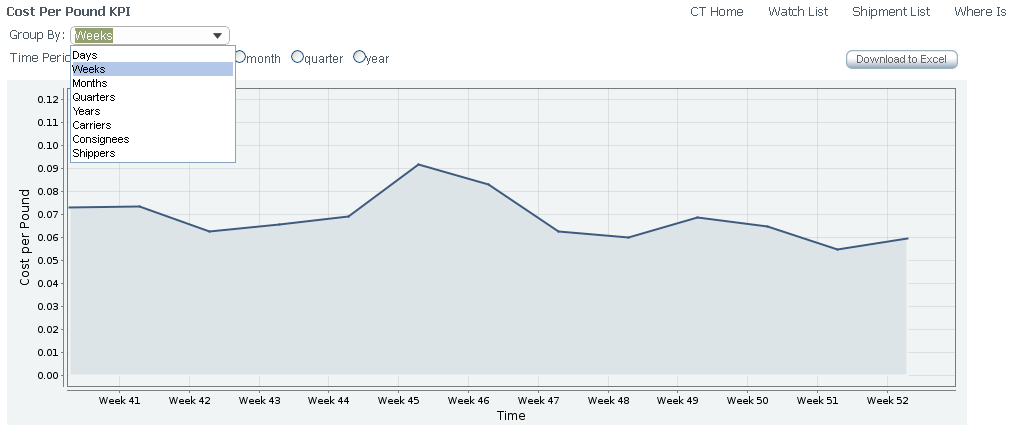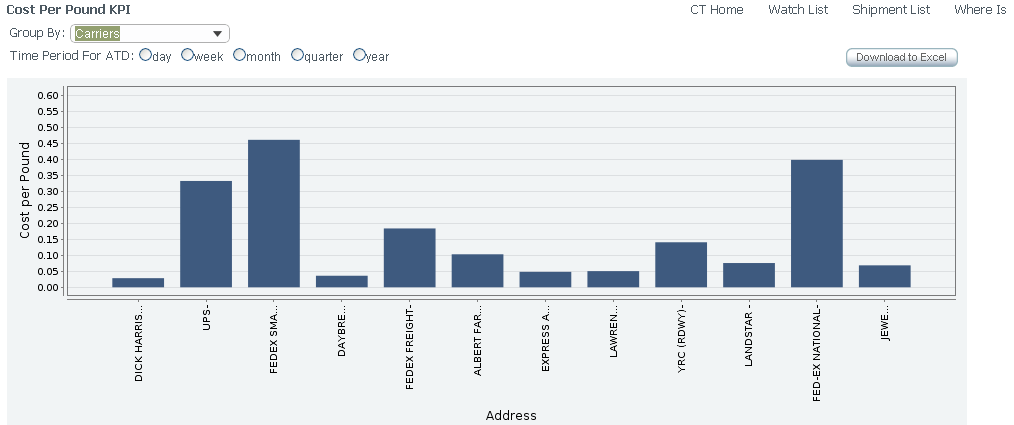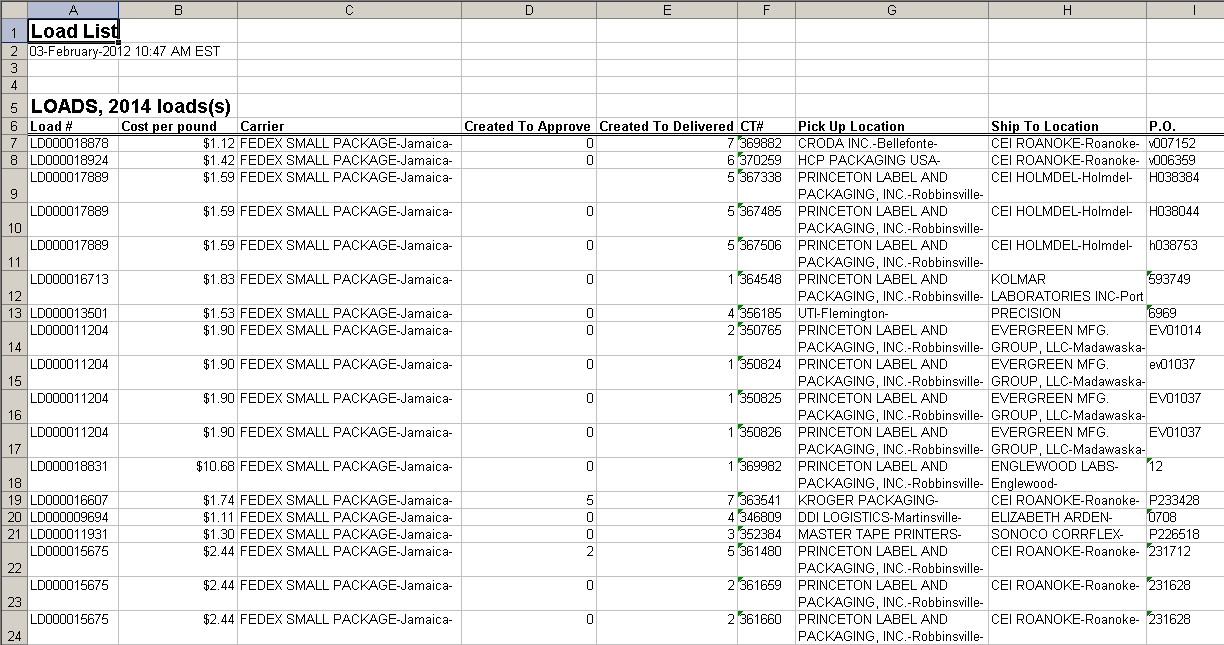DR KPI Framework (for non AR reports)
From UG
Contents |
Info
- 0003034 (* DR/KPI) ....... <proj>
Core Need
To produce common approach (if possible) to multiple DRs/KPIs in the system
- See specs for various KPIs in Category: DRs and KPIs such as Arden cost per pound, Cost per unit, etc
- AR DRs (Action Required DRs are outside of this for now). See Category: Action Required DRs
Requirements
See these wikis:
- Cost per pound KPI (TMS based Arden ) (solution) - first version is in production
- Cost KPIs (cost per unit) (concepts and requirements) - BA completed
- KPIs_for_OpsTruck#Average_times_KPI - BA completed
SOW 1
Summary
Solution designed to add more flexibility and new abilities of DR KPI:
- merge all KPI parameters (time periods/carriers) in one "Group By" parameter
- be able select separate grouping parameter
- set the number of segments on Axis X
- download to spreadsheet all results of chart on Level 2 (not only for one clickable bar on Level 3)
Glossary
- DR KPI Level 1 is a table of averaged KPI value (one or more) per sepecified time frame.
- Time frame for KPI calculating set on KPI settings tab in My Profile section.
- DR KPI Level 2 is a chart of one KPI that reflects averaged value of KPI's amount in relationship to certain parameter.
- Level 2 consists of 3 sections: Parameters, Chart, Filters
- DR KPI Level 3 is a spreadsheet of averaged KPI value (one or more) per sepecified time frame.
Preliminary works
- fix known bugs to make proper calculations on Level 1, including exception error message for "previous year" period
Improve Design
Level 2
NEEDS: * Change list of parameters displayed on Axis X - Time, Carriers, Consignees, Shippers * Change "time period" dropdown - remove "Days" / use "Group By" label instead "Axis X" * Linear chart for Time, bar chart - for others * Carriers and Truckers should be the same named (now aren't) - ask Mark!!! * add "Download to Excel" button
Common idea
- We suggest merge a time and other KPI parameters into one list.
- Chart data can be grouped by each parameter.
- Time Frame range can be set on Filters Panel in Delivery Date databoxes or by default on Time Period radio buttons section.
- (by default it is one measure unit range and depends from certain parameter).
We need to make the following updates:
1) in Parameters section
- update list of Axis X dropdown items to - day, week, month, quarter, year, carriers, consignees, shippers
- rename Axis X dropdown to Group By
- add "Download to Excel" button for results on Level 2
2) in Chart section
DR KPI on Level 2 is a chart of one KPI (on Axis Y) that reflects averaged value of KPI's amount per sepecified time frame and grouped by certain parameter (on Axis X).
- use following type of charts:
- linear chart for time parameters,
- bar chart for carrier parameters.
- display specified number of chart segments for "Group By" parameter
- When we select one of Time Period radio button then Chart segments reflect last time range per selected period.
- When we set Time Frame for Chart from Filters Panel the system calculates number of segments automatically in depends from Time Period.
Example 1 (linear chart, parameter Days):
Example 2 (linear chart, parameter Weeks):
Example 3 (bar chart):
3) in Filters section
- add Delivery Date "From" and "To" timeboxes
Look and feel
- All three parts of KPI frame work on level 2 (Parameter section, Chart section and Filters panel) should fit on one screen
- Labels features:
- when Group By = Quarters, label should be look like Q1-2011 ("Q"+Number of quarter - Four-digit year)
- when Group By = Carriers/Consignees/ Shippers, label should contain only name of carrier/consignee/shipper (without city name)
Level 3
NEEDS: * add new KPIs and update list of Output Fields * KPI overlapping - display several KPIs in adjacent columns
Look and feel
- Cost per pound KPI should be formatted as Currency with two decimals
- Time KPIs (Created To Approve, Created To Delivered) should be formatted as Integer Number
Example:
KPI settings
- default Time Frame (comply with Time Period from KPI Level 2)
- default Group By based on Time (days, weeks, months, quarters, years)
- TBD
SOW 2
Mantis: 3474: [DR/KPI] Create DR KPI Framework / External KPIs (SOW 2)
Core need
Implement 1 ‘date based’ KPI as a proof of concept
Intro
Common requirements for adding new KPI
To simplify further process of adding new KPI in CyberTrax we suggest use unified procedure of defining KPI.
- STEP 1. MO requests a new KPI and provides information for analysis.
- STEP 2. BA prepares information for development as list of key parameters:
- Key entity. Base of KPI or that for which the KPI is calculated.
- Example: shipment (for CT-based KPI), load (for Load-based KPI), user (for User-based KPI), trucker (for Trucker-based KPI).
- KPI function. Formula to calculate KPI. Result is always a number (integer or real).
- Should be shown on Axis Y in its own measure unit.
- Example: cost per pound/lane, created to approved/rejected/delivered.
- KPI measure unit. Name of units in which the KPI is to be measured.
- Example: USD (Cost and value KPIs), Day (Date KPIs).
- Key Date rule. Points or expression for key events of KPI (created, approved, delivered etc).
- Mostly depends from KPI family (cost, date) or KPI base (key entity).
- Example: Created on Date, Approved Date, Actual/Estimated Delivery Date.
- "Group By" methods. List of categories which can be used for grouping of KPI on Chart.
- Will be shown on Axis X.
- Each KPI has its own set of group by (default + specific).
- Should correspond with the default settings (ideally be the same).
- Example: days, weeks, months etc; carriers, users etc.
- Filters.
- Set of possible rules to select data slice by some value.
- Default set of filters.
- Specific filters for KPI family or one KPI.
- Chart types.
- Example: line, bar, pie. Note: for Group By = Carriers makes no sense to use linear chart.
- XLS output fields.
- Subset of values from KPI base object to output in spreadsheet (define default columns), their order of sequence, mapping and formatting.
- Example: days, weeks, months etc; carriers, users etc.
- Default settings.
- Time Frame. Range of dates per which is calculated KPI value for Level 1. Also it used for visualization of KPI at first time opening of Level 2.
- Group By. It defines method the grouping of subset of values of selected KPI per Time Frame on Chart (Level 2).
- NOTE: Defaults should contain only appropriate values for certain KPI.
- STEP 3. Developer implements solution that suggested the BA with using prepared key information.
Solution
Proof of concept of new KPI
We select "Created To Delivered" KPI for using as example.
STEP 1
Define KPI
Core of ‘date based’ "Created To Delivered" KPI is number of days since the date of creation the shipment until the date of its delivery.
STEP 2
Define key parameters
- KPI entity is a shipment.
- KPI function is difference between Created On Date and Actual Delivery Date.
- KPI measure unit is a day.
STEP 3
Implementation parts
- Client Visibility Rules
- Settings
As usual default values of KPI parameters should be set up in My Profile section.
- Date KPI panel settings should be added.
- We need ability to set up default values for parameters:
- "Time Frame"
- "Group By"
- Level 1
Initial KPI displaying.
- A table with 4 columns:
- Name of KPI,
- Time Frame range,
- KPI value (KPI measure in round brackets),
- Change.
- Headers: Name, Time Frame, KPI, Change.
- Level 2
Chart displaying.
- Level 3
Spreadsheet displaying.






